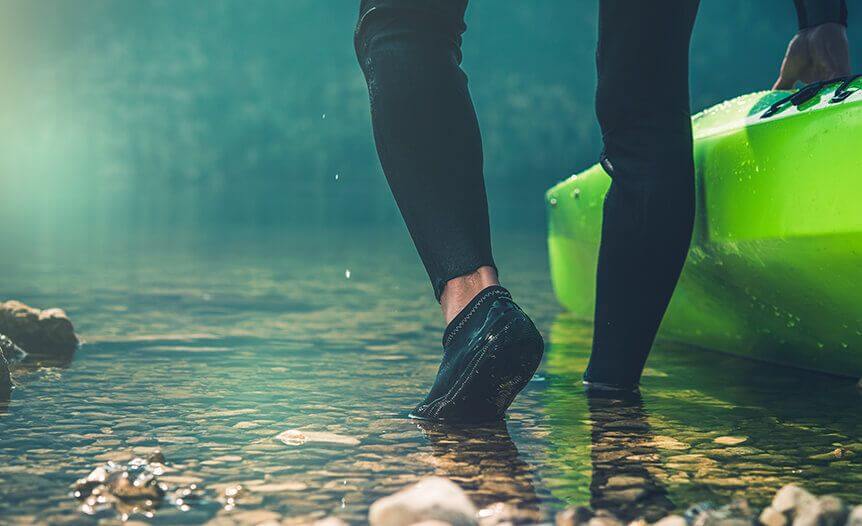Ultimate Guide to Fishing In Kayak
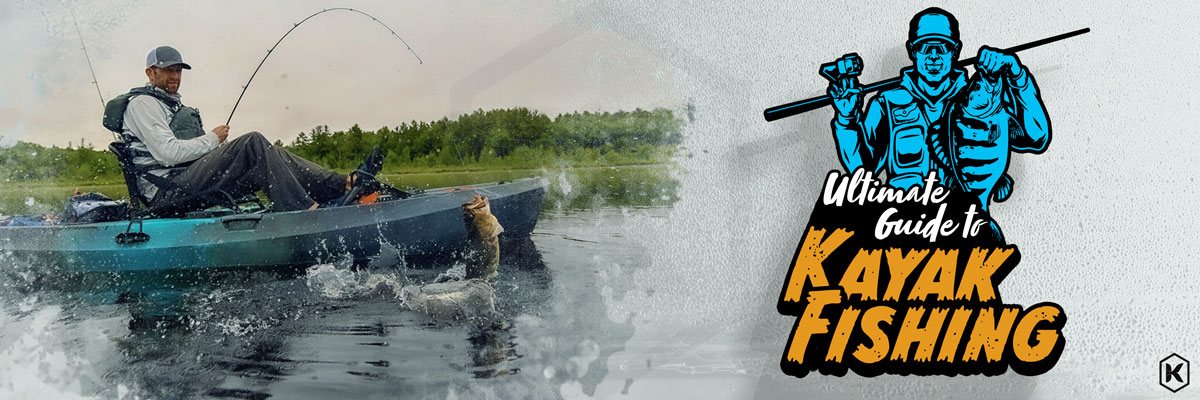
Whether you are a beginner or an advanced kayaker, this ultimate guide packs everything you need to get started with fishing from a kayak.
If you’re looking for information about kayak fishing for beginners, you’ll find them all in this article. Here we have covered many different topics and answered many common questions regarding fishing from a kayak.
If you are interested in kayak fishing setups, we’ll discuss many of the options available. As with all new hobbies and experiences, reading up on guides and tactics can be the perfect introduction.
When setting up for the first time there are many ways to do it, and each kayaker will have a different method. In fact, you may not find two kayakers that have the same setup!
Fishing from a kayak is an enjoyable pastime as it provides an excellent experience. It gets you away from the restrictions of land-based fishing but does not come with the high costs and expenses that you’ll get from owning a large boat.
One of the many advantages of fishing in a kayak is its portability. You can launch a kayak from any location you can walk to; no more waiting at a busy boat ramp or needing to know when the tides are best for getting into the water. Read on to find all about fishing kayak setups in this ultimate guide to fishing from a kayak in Australia.
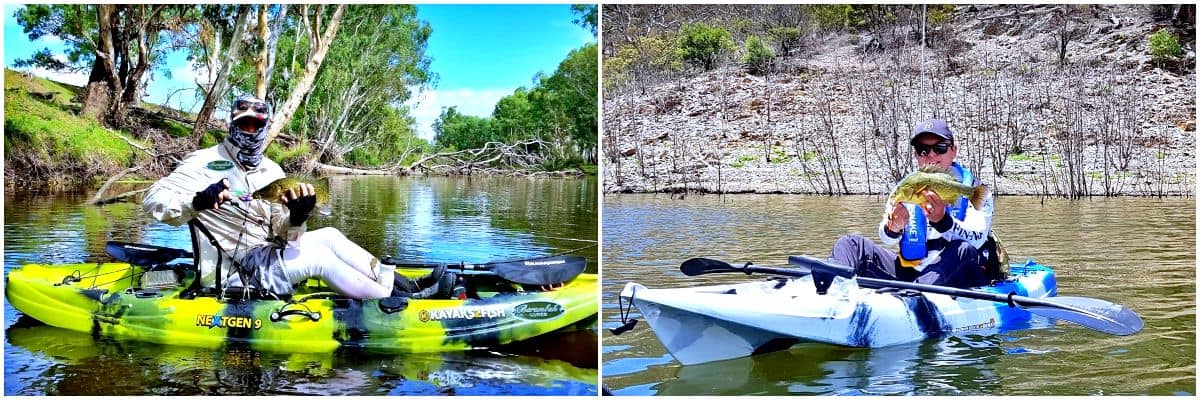
Why is kayak fishing good?
If you ask kayak anglers they'll often say that kayak fishing is an easy and inexpensive way of getting out on the water to catch some fish. You can take a kayak into fresh and saltwater with ease, and there are few restrictions on where you go (although it is best to avoid shipping lanes!). Many may consider it the perfect outdoor recreation activity.
If you’ve been fishing from land and have thought about getting out on the water, buying a kayak for fishing can be an excellent introduction.
Almost anyone can handle a kayak as they do not need a lot of physical strength to operate; they can actually help increase your fitness as they are paddle-powered.
Can you fish from a regular kayak?
Almost any kayak will be suitable for fishing, but choosing one purposely built for the purpose in mind is ideal, especially for anyone new to the sport.
If you look at many fishing articles, you can be quickly inundated with advice, and not all of it is suitable when you’re looking for kayak fishing for beginners tips. Here are a few features you may want to think about:
- Elevated seating
- Multiple flush mount rod holders
- Paddle holder & safety strap
- Suitable storage - enclosed hatch and bungee straps
- Fish Finder mounts
- Overall weight
- Side-tracks to install swivel rod holders
- Storage area for lures and baits
When looking at a fishing kayak to buy, consider where you’ll use it and your current skill level. If you're only getting started, then look for stability and one with plenty of storage spaces.
As your skills develop, you may wish to upgrade to one that provides speed over stability later on. Decide on how many rods you want to use, and choose a kayak that has enough mounting points and plenty of rod holders.
If you're not that keen on operating a paddle, then you can consider the pedal-powered kayaks. A pedal-powered craft is ideal as it'll give you excellent speed and will keep your arms free for more important duties!
Can you fish while kayaking?
While it is best to fish from a kayak in a stationary manner, it is entirely possible to fish while you're moving. Buying a trolling motor and rudder kit for your kayak can help keep your hands free for casting.
However, if you have a tandem kayak, one person can do the paddle work while you relax out the back with a fishing rod.
What is the best bait for kayak fishing?
The bait you choose will depend on what species of fish you are targeting. However, as you are limited to space, it is best to use baits or lures that do not need a lot of preparation. If you choose bait that needs to be cut up, this is easier to do before you head out on the water.
Many anglers will avoid bait all together and rely on lures to catch fish. Some anglers will even have several rods set up, with a rod or two loaded with baits and placed into flush mount rod holders, while they use another rod with a lure.
Naturally, getting hooked up on one or more rods creates its own set of problems, but more than one fish at a time is a great problem angler would love to have!
Is it hard to fish from a kayak?
When you're fishing from a kayak, you'll note the experience is unique compared to other forms of angling. The hardest thing to get used to is controlling it and learning how it moves when casting and reeling fish in.
The amount of space you have on a kayak can make the activity challenging for some people, but others find it adds a level of interest as you need to prepare better before heading out.
While there are differences between kayak fishing and other forms, the positives far make up for any negatives. Not only can you get to places that many others cannot, but there is a lot of camaraderie among fishing kayakers.
An experienced kayak angler is well aware of the challenges and is often happy to offer tips to help you out when setting up for the first time.
What experience is needed for kayak fishing?
If you have fished from boats or land before, then learning the basics to control a kayak should be something you practise before heading out.
Find a section of still water on a day of little wind and paddle around until you feel comfortable steering and controlling it. Once you learn a few basics, like paddling, turning, and knowing how to board the kayak from the water, then you're ready to head out.
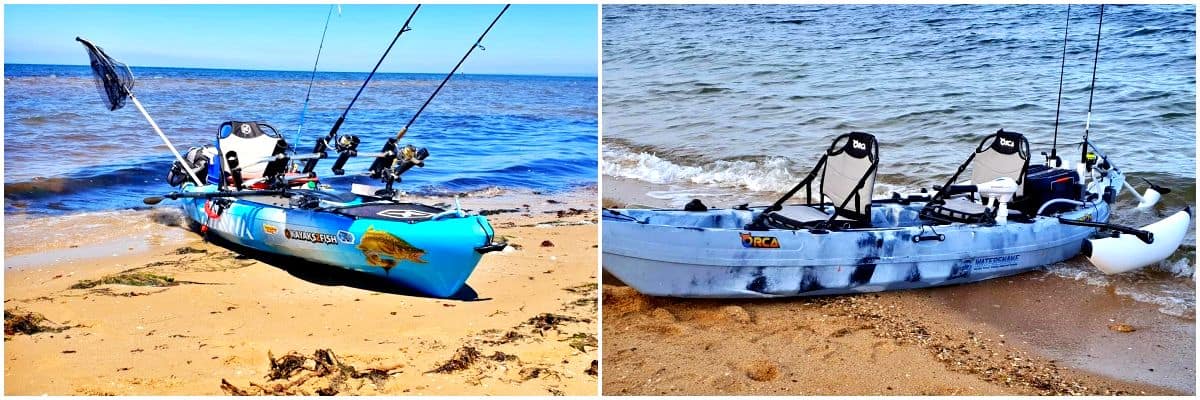
How to get started fishing from a kayak?
If you're confident using a kayak, then grabbing some fishing gear and learning how to fish is your next step. The best advice you can get is by watching videos on YouTube and talking to people in tackle shops. Let them know what you're planning on doing, and they'll give you sound advice on a rod, tackle, and bait selection.
How dangerous is kayak fishing?
When you are preparing to head out on the open water, you should familiarise yourself with general boating etiquette. As a small craft, the onus is on you to get out of the way of a larger craft. A personal flotation device (PFD) or lightweight inflatable life vest and an emergency beacon such as EPIRB is a must when out in deeper waters.
If you have propulsion systems, you may need a marine license in some states of Australia. However, many low powered trolling systems are exempt, it is best to check your license requirements with your local authority.
What safety equipment do I need for a kayak?
At all times you should wear a suitable life jacket. Try to find a life jacket (PFD) that allows you to have full range of arm movement. By keeping your arms free, it'll help when you're using a paddle. Try on various ranges of life jackets (PFD) and see how it affects your arms during a full rotation. An inflatable personal flotation device (PFD) is also a good lightweight option for confident swimmers who don't want the bulkiness of life jackets (PFD) and want the full range of arm motion.
Swimming with a life jacket should be something that you practise on occasion. The best life jacket (PFD) will fit snug and not move around too much, but it shouldn't be overly tight, so it is hard to move. Find a comfortable balance, and you'll have a perfect fit.
In Australia, many states impose fines for not wearing a life vest, so make sure to check your local state laws.
Will I get wet when I fish from a kayak?
When you’re out on a kayak one thing is a given - you’re going to get wet. Make sure you are wearing clothes that are quick-drying, and also give you enough coverage that you don't get burnt by the sun. Wearing a suitable hat and sunscreen, even on cloudy days is an absolute must.
You can also add visibility kits (LED lighting, flags, etc), as it’ll make you more noticeable to other water users especially if it starts to get dark.
For people just starting, there is a high chance that you may end up in the water, so try not to wear anything that you don't want to get wet. An old pair of running shoes are ideal, and you can choose to wear socks if you prefer; it’s best to pack a spare pair for the drive home!
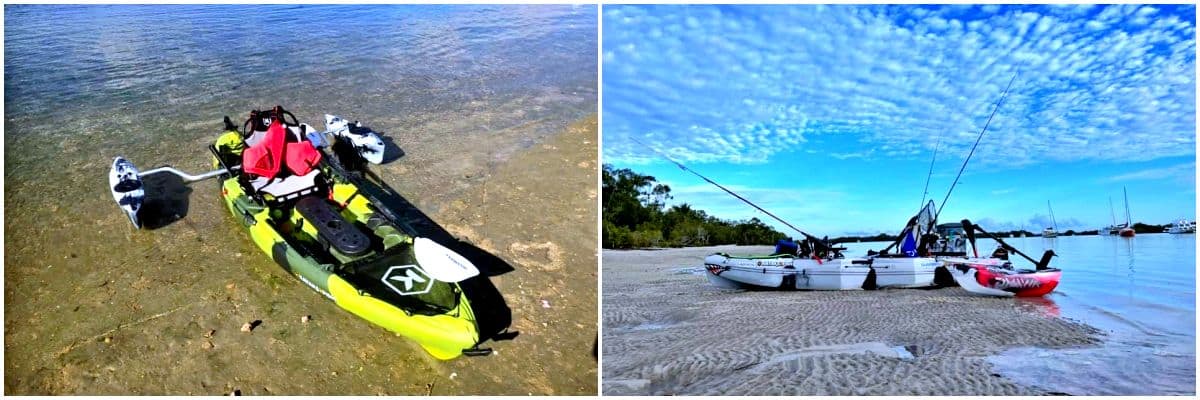
Are fishing kayaks stable?
Kayaks are designed to be very stable, provided you maintain the centre of gravity. If you lean over the edge then it can flip over.
When you first head out on your kayak fishing adventures, you may feel a little uneasy due to the motion of the boat, but this will soon settle, and you'll get used to the way it moves.
Most crafts are specifically designed for added stability, so much that you can comfortably stand up for casting and reeling fish in. However, if you hook a big one, it may be better to sit in the seat and keep your centre of gravity lower.
When you first head out and start paddling, it is best not to lean towards the water. Paddling in this manner may seem difficult initially, but by keeping your elbows tucked in, you'll find that your centre of gravity does not move too much.
As you get more experienced, you'll learn to balance properly to counteract movements, so you don't feel like the kayak will roll over. You can purchase an outrigger stabilizer kit to provide additional support.
For a demonstration about stability, you can watch this video:
Do fishing kayaks tip easily?
“To prevent flipping a kayak, it is best to distribute any items stored onboard in the middle of the kayak along its length.”
Kayaks are actually reasonably difficult to flip over. However, if they are used in the wrong conditions, it can contribute to how often they'll flip. They are designed for use in reasonably still rivers, lakes, and estuaries.
If you use it in high wind for traversing river rapids, or waves in the open water, they can flip over. To prevent flipping it, it is best to distribute any items stored onboard in the middle of the craft along its length.
Make sure you’re aware of the weight rating and that when you sit in it, you are positioned vertically in the seat.
While it is unlikely to flip over, it doesn't mean it won't happen. All kayakers should wear a suitable life jacket (PFD) at all times. When you are starting out it is essential to know how to get in and out of the kayak from the water.
If you have a pool or other nearby water source, you can practice getting in and out in a safe environment.
If you find yourself flipping over frequently or just want to be extra safe then a set of kayak outriggers is highly recommended.
How do you fish from a kayak?
Fishing in a kayak is a little different to most forms of fishing. The main difference is that you do not have a lot of space, and you'll need to only take what you'll use – if you forget anything behind in your car, it can be a long trip back!
Typically, casting is possible from a seated position, but it is easier standing up if your kayak design allows you to do so. Landing fish in a kayak can take some time to learn, but it won't take that long with a suitable net and having your craft organised.
How do you catch fish in a kayak?
Kayak fishing allows you to go many places that others cannot. You can get close to structures and into shallower waters that many other boats cannot.
If you're used to land-based fishing, you'll find that you can easily get to some areas that may have previously been inaccessible. Generally, this form of fishing is in between land-based fishing and boat fishing.
With the right setup, it is excellent for getting you to where the fish are, and your craft is silent enough that you won't scare any fish away. You can also use a fish finder to help you land those big fish while out on the water.
A fishing pole or rod is easy to carry. Most crafts come with multiple rod holders and they can be used to carry various types of rod setup, such as one with bait and another one with a lure fishing setup. Remember to use rod leashes to secure the rods.
Depending on the type of fish you are targeting such as bass, snapper or a flathead there is a whole range of lures you can buy, set up rods with various options and store them away from each other using the rod holder on board.
What do you do if you catch a fish in a kayak?
There are a few options when you catch a fish in a kayak; you can either keep or release it. As space is a premium on a boat this size, many kayakers only like to keep a certain number of fish.
Although you’re fishing from a kayak in Australia, you are still required to follow bag and size limits. You should have a size guide and a suitable measuring device on hand.
How to reel in a fish while in a kayak?
After you hook a fish, you can reel it in like you usually would. You may find that with larger fish you can get pulled about, but there are options for adding an anchor to help keep you still. When the fish is close to your craft, use a net to get it on board.
The best fish nets are made of quality materials that will not harm the fish, and that’s perfect if you are releasing them. After you have the fish in the net, lift it on board and then put it into a suitable storage container to take home or safely release it.
How do you keep fish while kayaking?
How you store fish caught is a part of setting up. When on land or a boat, most people will use a bucket or a purpose-built fishing hold. On a kayak, you have less space, but there are several options for keeping fish.
Having a high-quality cooler box with an easy locking lid can be an excellent option. You can also use keeper nets in the water next to you to keep your fish alive for the duration of your trip until you reach dry land.
What type of kayak is best for fishing?
“When choosing a fishing kayak, consider what you plan on taking with you and buy one that matches your style.”
Almost all kayaks are suitable for fishing. However, some are specifically designed for this purpose. A fishing kayak is versatile because it is suitable to be used for fishing and regular kayaking.
While it may not be as fast as other kayaks, they’re generally more stable, as they are built to withstand the rolling action while you are reeling fish in.
The best kayak for anglers is the one that provides various options to upgrade in the future.
How much weight can a kayak hold?
When looking at a kayak for fishing, you can consider the amount of weight it can hold. It will have a maximum operator weight and a maximum overall weight capacity. For example, the user weight is 120kg, but the overall weight is 150kg. This means if you weigh 120kg, you can take an additional 30kg on board.
Find one that can accommodate yourself and all the gear you plan on taking. However, don't forget that you'll need to account for any potential fish you catch and keep.
Adding a trolling motor and battery can significantly increase the weight, so choose wisely.
What features are best for a fishing kayak?
Fishing kayaks will have many built-in features. These can include spaces for rod holders, extra storage compartments, and many other optional extras. When choosing one consider what you plan on taking with you and buy one that matches your style.
How much is a kayak for fishing?
One of the best things about kayak fishing is that it is very affordable. If you have a car and a good set of roof racks, you can transport it easily. When looking for a kayak to buy, check that they come with a standard seat and paddle; some retailers may leave out that detail! You should also check if it comes with a sturdy paddle (not just any flimsy paddle), paddle leash and a good kayak hatch.
Some are small enough to be transported in the tray of a Ute. Having a good set of kayak roof racks is ideal for all other vehicles. If you need assistance lifting it onto the roof of your car, look for suitable kayak loading devices.
With kayaks for fishing, you'll notice there are several different models available. Have a look at all the optional extras, and decide if you'll make use of these. For casual recreational fishing, you may not need additional support for items like a fish finder. However, if you think you may like to use one in the future, buying one with a pre-installed track mount can save you some trouble down the track.
While many people focus on the kayak, some important equipment you'll need include your life jacket (or personal floatation device).
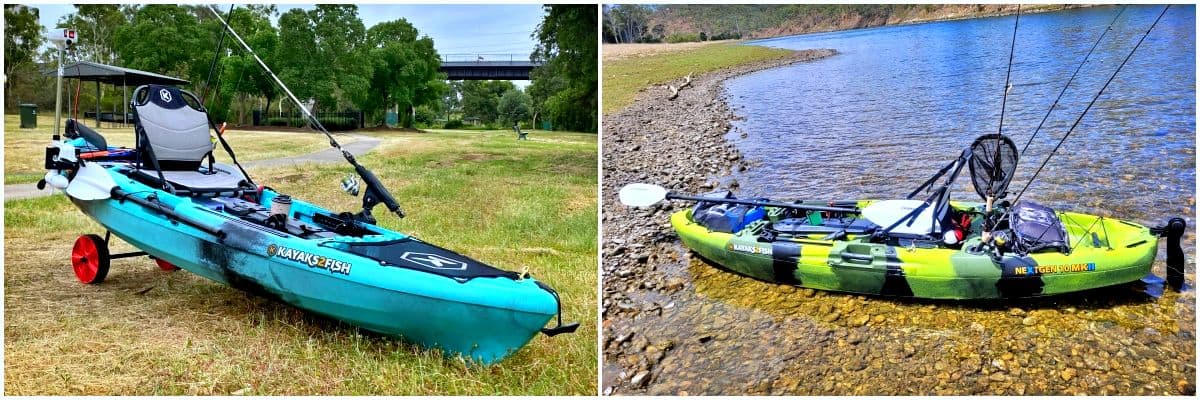
What accessories should I get for my fishing kayak?
“Take notes every time you head out and consider what optional extras can improve your experience.”
If you are already fishing, you don't need to buy any additional equipment to complete your fishing kayak setup. All you need is the craft of your choice and to get out on the water! A high-quality craft designed for fishing will have plenty of spaces to store all your fishing gear.
As you'll get wet, it may pay to invest in a waterproof tackle box. But, the best way to determine what gear you need to get started. Take notes every time you head out and consider what optional extras can improve your experience.
With kayak fishing for beginners, it is best to talk to others and get some good advice on what you may like to add to your arsenal.
Most anglers would get a milk crate and use it to attach DIY rod holders and carry other essential gear.
How do I make my fishing kayak better?
The easiest method to improve your kayak fishing skills is to talk to other kayaker anglers. There are many clubs you can join, and get excellent advice from. These clubs can introduce you to new locations, and many will go out on the water together. Adding equipment to your fishing kayak setup can also help improve your abilities. This may include a fish finder, flush mount rod holders or swivel rod holder, an anchor system (including an anchor trolley). Adding essential equipment can assist a new fisherman. These can include accessories like extra rods, small tackle boxes, rod leashes, and other gear.
What if I want to kayak fish alone?
If joining a kayak anglers club is not for you, you can get a ton of tips from watching videos on YouTube. Many anglers will talk about casting from a kayak and how to improve their chances. Find a channel that gives expert advice and what optional extras may improve your day out on the water. If you're only starting out, it may be best to stay in shallow water. When your skills improve, it is possible to head out into deep water and look for big fish.
How else can I look for tips on kayak fishing?
When you're looking for kayak fishing tips, you can also get good advice from local tackle shops. Wherever you stop to buy bait and stock up on hooks and other fishing equipment is a brilliant source of information. Many of the people that run these shops are local, and they know the waters quite well. While you may not learn all their secrets, they'll give you a good head start!
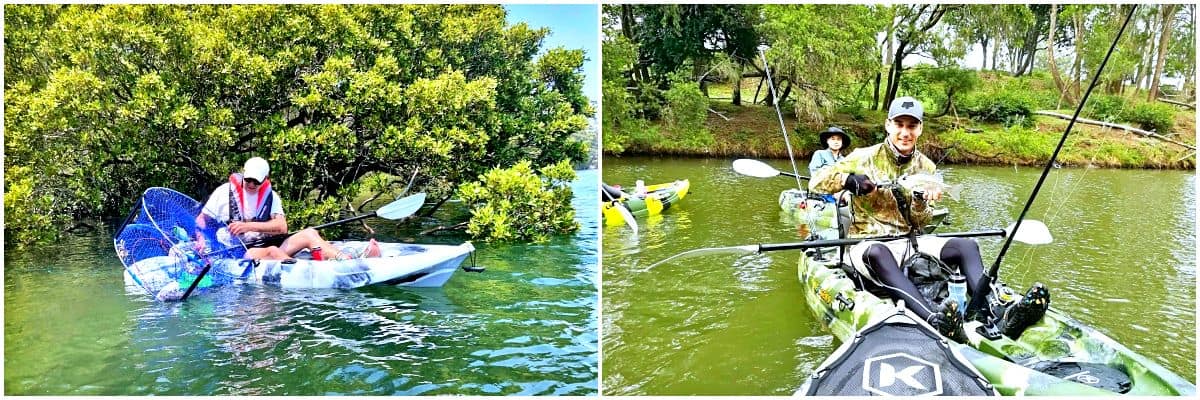
How do you set up a kayak for fishing?
When setting up a fishing kayak, it's important to note that you only have a certain amount of space to work with, and everything needs to be within arm's reach.
They generally have four sections (stern, seating, middle hatch, and forward deck), all of which can be used for storage. Layout all your accessories and gear and keep the items you use the most in the nearest compartment or some sort of tackle boxes.
Don't overload your kayak for fishing. The first tip any kayak angler will give you is not to overload your kayak. Have a look at the specifications and see what overall weight it can safely operate under.
Everything loaded on the craft should be kept to the centre. If you stack too many things to the side, it can cause instability issues. Also, spread out your rods in various rod holders away from each other.
What extras are best for my kayak?
Kayak anglers may suggest a wide variety of accessories and gear you may wish to add. These will include a fish finder, landing nets, rod holders, tackle box, anchor system, trolling motor and milk crates to keep you stay organised.
An anchor system is one of the best accessories to have when you need anchoring in a fast running tide or when you just want slow drifting. Anchor trolley allows you to move the anchoring point on the craft, a very handy option to have.
Everyone's exact setup will be different, and what works for a typical kayak angler may not work for you. Trying awide variety of accessories and exploringwhat will be suitable for your needs is the best method.
Is it worth buying a kayak for fishing?
“If you're a beginner to kayak fishing, starting with a base model and adding on extras at a later date can be the best way to save money.”
When you're buying a kayak fishing setup, there are models to suit all budgets. If you're a beginner, starting with a base model and adding on extras at a later date can be the best way to save money. There are many small models available, which will mean that your financial entry point to the sport is low.
If you are comparing it to buying a boat, then there are many savings to consider. With a kayak, you don't need extra expenses like insurance, registration, or trailers for transportation. Accessories on kayaks are also cheaper than a boat.
It is also incredibly easy to store than boats as they fit in most garages and sheds with ease. If you're looking to keep it in the garage, you can use some of the many storage devices available.
Kayaks used for fishing are also brilliant for regular recreational use. They can be used as a swimming platform or for just relaxing out on the water. They are easy to transport, getting them to and from water isn't a hassle, and you won't even need to wait for the tides!
After the trip, cleaning it is a breeze as opposed to a boat. Boat owners can relate to this more than anything.
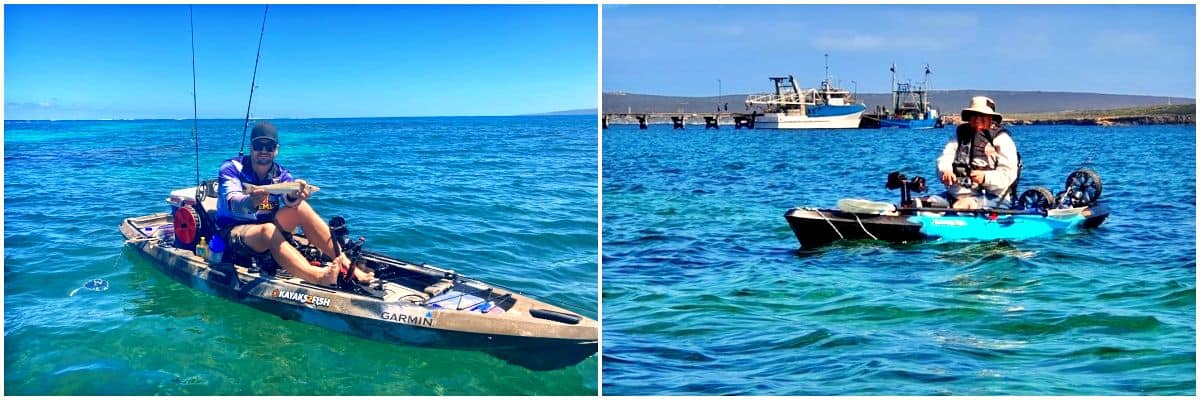
Can you use a fishing kayak in the ocean?
Using a fishing kayak in the ocean is not only possible, but it is also one of the best ways to get in close to structures and sneak up on fish schools.
When out in the open water, there are advantages that some types of kayaks will have over others.
While it is possible to use any kayak to fish, for increased onboard storage, mobility of the kayaker, and your position in the water, a sit on top canoe is better than a sit-in canoe.
When you are saltwater fishing, there are many differences that can make it more challenging than freshwater angling. Firstly, you deal with much larger fish, which can pose a problem, especially when you're trying to land one safely.
Before heading out, make sure you're confident using it and you know how to get back on the craft safely if you fall overboard.
It is best to find a sea kayak anglers group. Planning a trip with a friend or in a larger group can be ideal for helping out if you end up in any trouble. By going out together, you'll get to know the region, and you'll have plenty of great tips and advice to rely on.
When you're with more experienced sea kayakers, you'll gain an appreciation for the local area. They'll help you have a complete understanding of things such as coming in with the tides or knowing when the weather will turn on you.
What size kayak is best for sea kayaking
To choose the best kayak, find one that is well known for stability, and learn how to stand up as that will help you cast and reel fish in. For saltwater fishing, a right kayak of approximately 3-4m is ideal and makes sure you have plenty of storage spaces available for your tackle boxes.
Keep comfortable while sea kayaking. Your comfort when saltwater fishing is very important. Be sure to wear some sun protection, and your personal floatation device (PFD). Always make sure thepaddle leash is secure, as it can be a long swim if the paddle slips overboard.
Make sure your kayak has a good quality seat, and the higher you can sit, the better. A high vantage seat will allow you to stand easier, and it keeps you further away from any water in the craft. As you'll be on the water for a few hours, sitting in a good position will stop you from getting tired.
After you finish for the day, you'll need to wash it down. If you can do it immediately after you finish, this is great, but if not, it can wait until you get home. Give the entire craft a good cleanout; the saltwater may affect some of the metal parts.
How far offshore should a kayak be?
“Conditions at sea can change very quickly, and if things go bad, 1km from shore can feel like 10km.”
Generally, you shouldn't go out further than you're comfortable. Conditions at sea can change very quickly, and if things go bad, 1km from shore can feel like 10km.
When you're starting out, it's advisable to not go any further away than you can swim, especially if you're travelling alone. If you're in a group, the people are around to give you a hand if you need it. Remember safety first.
If you're not that confident in your kayaking skills, spend the time to get your fitness and skills up, as that can allow you to travel further distances. Having a backup to your plans, like an electric outboard, can assist you if there is any trouble and you need to get back to the dry land fast.
Try not to rely too much on what others say about distance, as 10km away from shore to an experienced kayaker may not seem like a lot to them. Know your limits, if at any time you feel uncomfortable it may be time to come in closer to the shore.
Always check local Australian weather apps before you head out to be safe. BOM website is a great resource in Australia for that, especially keep an eye on the wind conditions. Considering wind speed is a major factor to remain safe.
What do I need for saltwater kayak fishing?
The equipment you take in saltwater will depend on what species of fish you're targeting and how fast you want to get around. All good quality kayaks will come with a paddle; however, you may wish to upgrade to an electric outboard motor.
These outboards will help you get around, and they save your arms for casting and reeling fish in. For safety reasons, you can add reflective tape to your kayak. This will help you to be seen by other vessels, especially during low light conditions.
As large fish can pull you around, you may prefer to install a small kayak anchor to help keep you grounded. An anchor will also help you if the wind picks up a bit and starts to push you around.
Most can accommodate multiple rods, but it is best to check with the fishing rules in your area for how many rods you can have. Also, make sure you know your bag limits!
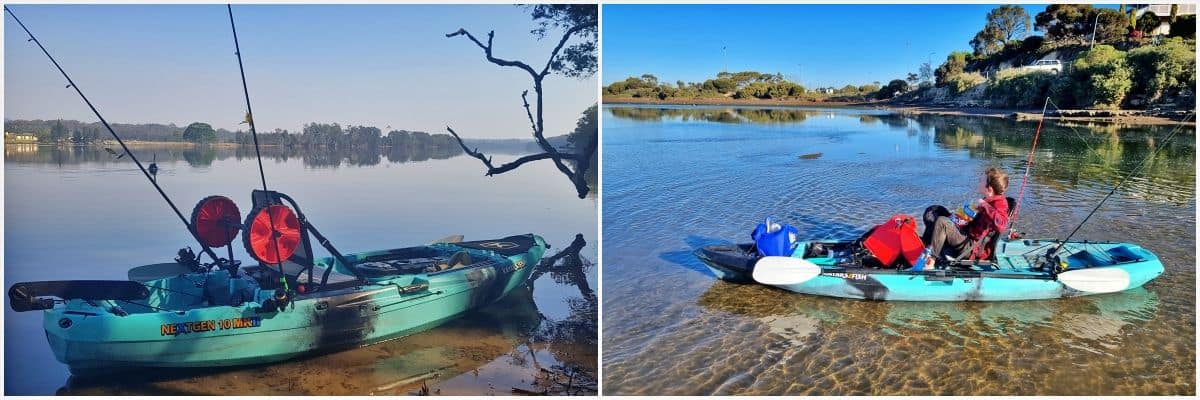
Conclusion: Getting started with kayak fishing
After you get your kayak and go out a few times, you’ll build experience and soon work out the best way to make your journey a complete success.
At Kayaks2Fish, our suggestions for new owners include kayak trolleys to help you get it from your car to the water and a kayak sunshade to give you added protection from the sun.
At Kayaks2Fish, you’ll find everything you need and more to get you started on your journey. From your first kayak to all the necessary equipment, you’ll find them all in our online store.
If you’re interested in going out on your own or have the family in tow, there are kayaks suitable for everyone. We have pickup locations in Melbourne, Sydney, Brisbane, Adelaide, Perth, and several others all over Australia.
You can also have your kayak or any other equipment shipped directly to your home address or a depot near you anywhere in Australia.
It is an inexpensive and enjoyable way to get out on the water and explore your local region. The kayaks are highly transportable on the roof of your car, and they stack together, so it doesn’t matter if you have one or three.





